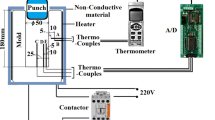Abstract
In the present work, a mathematical model was developed based on finite difference method to predict the microporosity distribution in A356 aluminum alloy casting. Heat, mass, and gas conservation equations were solved in this model. Moreover, Darcy’s equation was considered in the mushy zone. Results show that the distribution and concentration of microporosities in cast parts vary with both cooling rate and initial gas content. Simulation results were compared with experimental data where proportionally good agreement with experimental results was found. Finally, a complex cast part was simulated presenting the ability of the model to predict the porosities in industrial cast parts.
Similar content being viewed by others

References
Campbell J (2000) Casting. Butterworth Heinemann, United Kingdom
Zou J, Shivkumar S, Apelin D (1990) Modeling of microstructure evolution and microporosity formation in cast aluminum alloys. AFS Trans 98:897–904
Pequet Ch, Gremaud M, Rappaz M (2002) Modeling of microporosity, macroporosity, and pipe-shrinkage formation during the solidification of alloys using a mushy-zone refinement method: applications to aluminum alloys. Met Mat Trans A 33:2095–2106
Zhu JD, Cockcroft SL, Maijer DM (2006) Modeling of microporosity formation in A356 aluminum alloy casting. Met Mat Trans A 37:1075–1085
Hanzel JG, Keverian J (1965) The theory and application of a digital computer in predicting solidification patterns. J Met 5:83–91
Imafuku I, Chijiwa K (1983) A mathematical model for shrinkage cavity prediction in steel casting. AFS Trans 91:527–540
Pellini WS (1953) Factors which determine riser accuracy and feeding range. AFS Trans 61:61–80
Niyama E, Morikawa M (1981) Prediction shrinkage in large steel casting from temperature gradient calculation. Int Cast Met J 6(2):16–22
Lee YW et al (1990) Modeling of feeding behavior of solidification Al–7Si–0.3Mg alloy plate casting. Met Trans B 21:715–722
Sabau AS, Viswanathan S (2002) Microporosity prediction in aluminum alloy castings. Met Mat Trans B 33:243–255
Katzarov IH (2003) Finite element modeling of the porosity formation in castings. Int J Heat Mass Transf 46:1545–1552
Atwood RC, Lee PD (2002) A three-phase model of hydrogen pore formation during the equiaxed dendritic solidification of aluminum–silicon alloys. Met Mat Trans B 33:209–221
Kubo K, Pehlke RD (1985) Mathematical modeling of porosity formation in solidification. Met Trans B 16:359–366
Apelian D, Flemings MC, Mehrabian R (1974) Specific permeability of partially solidified dendritic networks of Al–Si alloys. Metall Trans B 5:2533–2537
Murakami K, Okamoto T (1984) Fluid flow in the mushy zone composed of granular grains. Acta Metall 32:1741–1744
Poirier DR, Ocansey P (1993) Permeability for flow of liquid through equiaxial mushy zones. Matls Sci Eng A 171:231–240
Brown SGR, Spittle JA, Jarvis DJ, Walden-Bevan R (2002) Numerical determination of liquid flow permeabilities for equiaxed dendritic structures. Acta Mater 50:1559–1569
Mirbagheri SMH, Chirazi A (2006) Simulation of interdendritic liquid permeability for low and high solid fractions during the solidification of mushy alloys. Mat Sci Eng A 427:51–59
Bernard D, Nielsen O, Salvo L, Cloetens P (2005) Permeability assessment by 3D interdendritic flow simulations on microtomography mappings of Al–Cu alloys. Mat Sci Eng A 392:112–120
Khajeh E, Mirbagheri SMH, Davami P (2008) Modeling of permeability with the aid of 3D interdendritic flow simulation for equiaxed dendritic structures. Mat Sci Eng A 475:355–364
Santos R, Melo MLNM (2005) Permeability of interdendritic channels. Mat Sci Eng A 391:151–158
Carman PC (1937) Fluid flow through granular beds. Trans Inst Chem Eng Lond 15:150–166
Viswanatan S et al (2001) Design and product optimization for cast light metals. CRADA final report
Kurz W, Fisher DJ (1998) Fundamentals of solidification, 4th edn. Trans Tech, Switzerland
Shabani MO, Mazahery A, Bahmani A, Davami P, Varahram N (2011) Solidification of A356 Al alloy: experimental and modeling. Kovove Mater 49:253–264
Mantaux O, Lacoste E, Danis M (2002) Numerical prediction of microporosity formation during the solidification of a pure metal within a porous perform. Compos Sci Technol 62:1801–1809
See D, Atwood RC, Lee PD (2001) A comparison of three modeling approaches for the prediction of microporosity in aluminum-silicon alloys. J Mat Sci 36:3423–3435
Patankar SV (1980) Numerical heat transfer and fluid flow. Hemisphere, USA
Bācherud L, Chai G, Taminnen J (1990) Solidification characteristics of aluminum alloys, 2nd edn. Foundary Alloys, Norway
Author information
Authors and Affiliations
Corresponding author
Rights and permissions
About this article
Cite this article
Bahmani, A., Hatami, N., Varahram, N. et al. A mathematical model for prediction of microporosity in aluminum alloy A356. Int J Adv Manuf Technol 64, 1313–1321 (2013). https://doi.org/10.1007/s00170-012-4102-7
Received:
Accepted:
Published:
Issue Date:
DOI: https://doi.org/10.1007/s00170-012-4102-7



